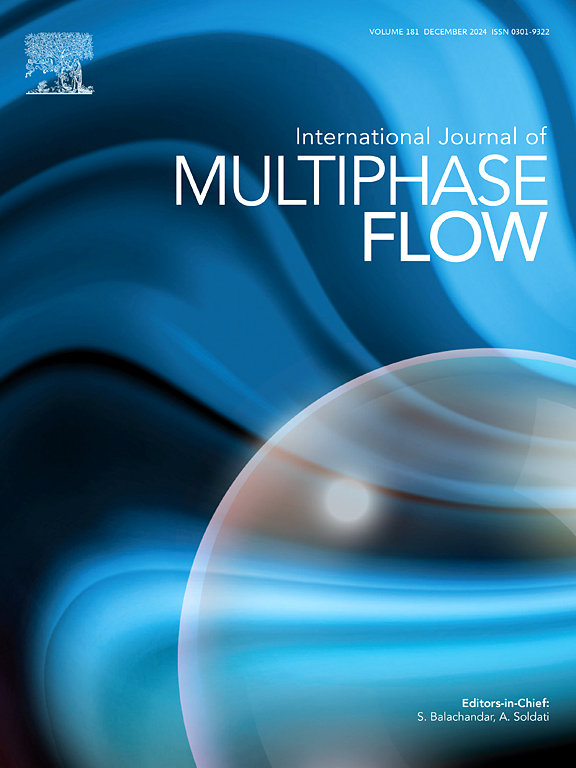Intelligent and quantitative ligament breakup event analysis in 65 kHz off-axis holographic video of swirl spray
IF 3.8
2区 工程技术
Q1 MECHANICS
International Journal of Multiphase Flow
Pub Date : 2025-07-11
DOI:10.1016/j.ijmultiphaseflow.2025.105337
引用次数: 0
Abstract
The mechanism of ligament breakup events in sprays significantly impacts both daily life and industry, particularly with regard to swirl sprays in aero-engines. Specifically, three critical challenges must be addressed: tracking the trajectories of ligaments across frames, elucidating the relationships between parent and daughter ligaments, and capturing the spatial and temporal information of breakup events. This study introduces an intelligent pipeline for the quantitative analysis of ligament breakup events. The integration of Segment Anything Model 2 (SAM 2) enables automatic segmentation, producing ligament masks from low signal-to-noise ratio holographic videos. To effectively provide prompt information, four techniques are proposed: YOLO detection for initial bounding box prompts, box post-processing, video clip generation, and prompt giving. Based on the preliminary masks generated by SAM 2, the grayscale values of the masked pixels are utilized for refined segmentation through clustering of K-means, accurately delineating the internal structures and edges of the ligaments. A manually curated validation dataset is established, and three evaluation metrics (precision, recall and F1 score) are used to assess the segmentation performance of seven different methods, demonstrating the superior efficacy of the proposed approach. The influences of frame rate and image quality are also discussed. Subsequently, the centroids and areas of connected regions within the segmentation results are extracted. A light flow field is utilized to initiate ligament trajectory matching. To determine the relationship between parent and daughter ligaments during the breakup process, the stability of relative horizontal positions between connected regions before and after the breakup is analyzed, significantly reducing the calculation time. Finally, breakup lengths, ligament lengths, and breakup times are calculated to represent the statistical characteristics of breakup events.

65 kHz旋流喷雾离轴全息视频中韧带断裂事件的智能定量分析
喷雾器中韧带断裂事件的机理对日常生活和工业都有重大影响,特别是航空发动机中的涡流喷雾器。具体来说,必须解决三个关键挑战:追踪韧带跨帧的轨迹,阐明母韧带和子韧带之间的关系,以及捕获断裂事件的时空信息。本研究介绍了一种用于韧带断裂事件定量分析的智能流水线。集成了分段任意模型2 (SAM 2),实现了自动分割,从低信噪比全息视频中产生韧带掩模。为了有效地提供提示信息,提出了四种技术:初始边界框提示的YOLO检测、框后处理、视频片段生成和提示给出。基于SAM 2生成的初步掩模,利用掩模像素的灰度值,通过k均值聚类进行精细分割,准确勾画出韧带的内部结构和边缘。建立了人工编制的验证数据集,并使用三个评价指标(查全率、查全率和F1分数)对七种不同方法的分割性能进行了评估,证明了所提方法的优越效果。讨论了帧率和图像质量的影响。随后,提取分割结果中连通区域的质心和面积。利用光流场启动韧带轨迹匹配。为了确定母子韧带在断裂过程中的关系,我们分析了断裂前后连接区域相对水平位置的稳定性,大大减少了计算时间。最后,计算分手长度、韧带长度和分手时间,以表示分手事件的统计特征。
本文章由计算机程序翻译,如有差异,请以英文原文为准。
求助全文
约1分钟内获得全文
求助全文
来源期刊
CiteScore
7.30
自引率
10.50%
发文量
244
审稿时长
4 months
期刊介绍:
The International Journal of Multiphase Flow publishes analytical, numerical and experimental articles of lasting interest. The scope of the journal includes all aspects of mass, momentum and energy exchange phenomena among different phases such as occur in disperse flows, gas–liquid and liquid–liquid flows, flows in porous media, boiling, granular flows and others.
The journal publishes full papers, brief communications and conference announcements.

 求助内容:
求助内容: 应助结果提醒方式:
应助结果提醒方式:


